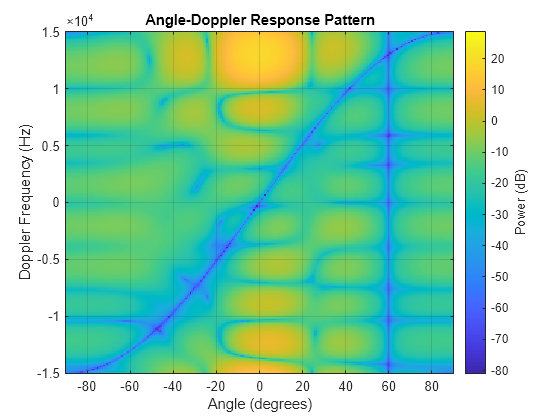step
System object: phased.ADPCACanceller
Namespace: phased
Perform ADPCA processing on input data
Syntax
Y = step(H,X,CUTIDX)
Y = step(H,X,CUTIDX,ANG)
Y = step(H,X,CUTIDX,DOP)
Y = step(H,X,CUTIDX,PRF)
[Y,W] =
step(___)
Description
Note
Starting in R2016b, instead of using the step method to perform the operation defined by the System object™, you can call the object with arguments, as if it were a function. For example, y = step(obj,x) and y = obj(x) perform equivalent operations.
Y = step(H,X,CUTIDX)X.
The algorithm calculates the processing weights according to the range
cell specified by CUTIDX. This syntax is available
when the DirectionSource property is 'Property' and
the DopplerSource property is 'Property'.
The receiving mainlobe direction is the Direction property
value. The output Y contains the result of pulse
cancellation either before or after Doppler filtering, depending on
the PreDopplerOutput property value.
Y = step(H,X,CUTIDX,ANG)ANG as the receiving main lobe direction. This syntax is available
when the DirectionSource property is 'Input port'
and the DopplerSource property is 'Property'.
Y = step(H,X,CUTIDX,DOP)DOP as the targeting Doppler frequency. This syntax is available
when the DopplerSource property is 'Input
port'.
Y = step(H,X,CUTIDX,PRF)PRF as the pulse repetition frequency. This syntax is available
when the PRFSource property is 'Input port'.
[
also returns the processing weights, Y,W] =
step(___)W. This syntax is available when
the WeightsOutputPort property is
true.
Note
The object performs an initialization the first time the object is executed. This
initialization locks nontunable properties
and input specifications, such as dimensions, complexity, and data type of the input data.
If you change a nontunable property or an input specification, the System object issues an error. To change nontunable properties or inputs, you must first
call the release method to unlock the object.
Input Arguments
|
Pulse canceller object. |
|
Input data. The size of the first dimension of the input matrix can vary to simulate a changing signal length. A size change can occur, for example, in the case of a pulse waveform with variable pulse repetition frequency. |
|
Range cell. You can specify this argument as single or double precision. |
|
Pulse repetition frequency specified as a positive scalar. To enable this
argument, set the |
|
Receiving main lobe direction. Default: |
|
Targeting Doppler frequency in hertz. Default: |
Output Arguments
|
Result of applying pulse cancelling to the input data. The meaning
and dimensions of
|
|
Processing weights the pulse canceller used to obtain the pre-Doppler
data. The dimensions of
|














